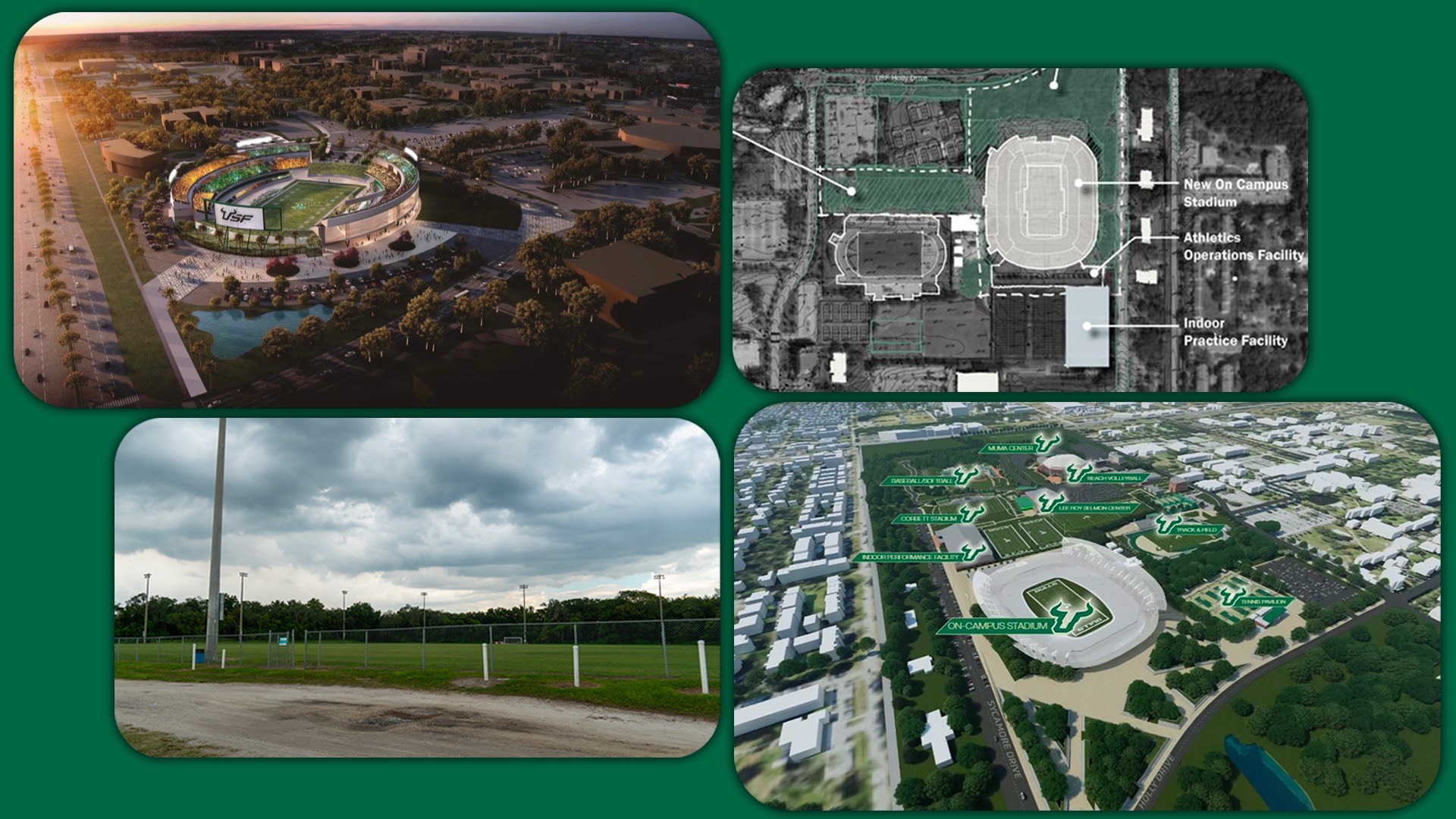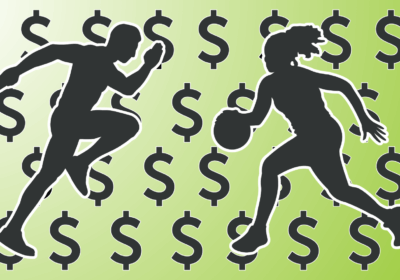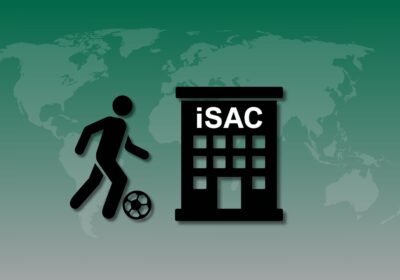Look back at the years-long evolution of USF’s on-campus stadium plans

A long-held dream of USF leadership, plans for the on-campus stadium have seen plenty of movement since the project was officially announced two years ago.
It now has an expected opening date of fall 2026 with an estimated $340 million price tag.
As the stadium comes closer to reality, take a look back at its evolution so far.
2016 – Genshaft ponders on an on-campus stadium
Years before President Rhea Law and the Board of Trustees (BOT) made an official announcement regarding an on-campus stadium, then-President Judy Genshaft hoped to make strides toward the stadium during her tenure.
In 2016, Genshaft contracted The Beck Group – a Dallas-based construction company – to do a concept plan of a 50,000-seat on-campus stadium. When originally evaluated for costs in 2017, the price was estimated at $200 million – $140 million less than its current estimated price tag.
At the time, there were two zones considered for the location of the stadium: the southwest corner of Fowler Avenue and Bruce B. Downs, or zone one, and the southeast corner of Fowler Avenue and USF Bull Run Drive on the existing Fowler Fields site, known as zone two.
2017 – Student referendum spearheaded by SG
In an effort to find financing for the stadium, Student Government (SG) conducted a referendum in 2017 where students could vote to pay a $6 to $9 per-credit-hour fee to fund the stadium.
For students taking 15 credit hours, the $6 fee would total $90 per semester whereas the $9 fee would equal $135.
Most students, however, disagreed with the proposed fee. Out of the 1,753 votes, 814 students voted against the fee, 618 voted in favor and 271 had no preference.
Currently, the stadium is being financed through a $200 million debt issuance. The remaining $140 million cost will be paid for by USF directly.
September 2021 – Weatherford promises a stadium
On the heels of a groundbreaking ceremony for the then-new Porter Family Indoor Practice facility, BOT Chairman Will Weatherford promised attendees at the ceremony an on-campus stadium.
“[USF] is a university that’s progressing in every metric academically, and [the athletics program] is ready to take on the challenge,” Weatherford said in a Sept. 8, 2021 article. “Frankly, this community, the students and the athletes, they deserve a stadium on their campus, they deserve to have it.
“We can do it, and we’re going to do it.”
Though no timetables or timelines were provided at the ceremony, Weatherford said the plans were under way. Former head football coach Jeff Scott – who was fired in November – said the on-campus stadium had been in talks for four months at the time.
December 2021 – Sycamore Fields proposed as location
Only four locations had been considered for the stadium until Vice President of Athletics Michael Kelly presented a fifth option: Sycamore Fields.
The previous locations included the southwest corner of campus near Bruce B. Downs Boulevard and Fowler Avenue, the intramural fields near Juniper-Poplar, the Museum of Science and Industry site and Fowler Fields.
When considering the locations, the BOT had the following criteria:
- Parking
- Transportation
- Existing site
- Distance to Athletics district
- Distance to student housing
- Visibility to public
- Sports operation facility
- Tailgating opportunities
- Future expansion
Sycamore Fields was brought to the table at a Dec. 7, 2021 BOT planning committee meeting due to the proximity to the Athletics district, parking and the on-campus student housing buildings.
The five locations were eventually narrowed to the now-official location in Sycamore Fields when the planning committee recommended it at a March 7, 2022 meeting.
September 2022 – Barton Malow and Populous in negotiations; opening date projected
Bringing the stadium one step closer, design and build team Barton Malow and Populous were announced to be in negotiations with the university in September 2022.
The groups have worked together on over 40 different sports venues in the country, including Penn State’s Beaver Stadium and Gillette Stadium in Massachusetts.
The Tampa-based construction firm, Barton Malow, has worked on other college stadiums like Notre Dame and the University of Michigan. The design firm, Populous, has worked on stadiums at Baylor, Colorado State and University of Minnesota.
USF also revealed a projected opening date for fall of 2026. The opening date has not changed since then.
June 2023 – BOT approves $340 million budget; Schneider votes Nay
Passing with a 4-1 vote, a $340 million budget was approved for the stadium on June 13. However, concerns from faculty did not go unnoticed.
Faculty senate president and BOT trustee Jenifer Jasinski Schneider was the only vote against the project. She voiced concerns regarding the benefits of the stadium and how financing and budgeting would affect the university.
Accounting for relocation projects that would have to be initiated to accommodate the stadium, Schneider said the price tag was actually much higher.
“That’s $44 million more, making it a $385 million project. And I know it’s not the end because we all know that when building things, other events are going to happen around us,” Schneider said in a June 14 Oracle article.
Schneider’s worry focused on the possibility of the $200 million debt service affecting the university’s academics.
Still, the budget passed through the BOT and progressed to its next hurdle: the Board of Governors.
September 2023 – BOG approves debt issuance; construction to begin in October
Marking the most recent development for the stadium, the BOG approved the $200 million debt issuance for the stadium on Friday.
Though originally projected at 5.13%, USF will take on the debt with an expected 6.68% interest rate. The final interest rate has not yet been determined, but will occur prior to Oct. 16.
The university is expecting to make an internal rate of return of $15.2 million within the first year, which alone would not be enough to cover the annual debt service of $19.8 million.
However, USF is expecting to make extra revenue growth to exceed the annual debt service figure in the following years. Eventually, the stadium would be active year-round and would receive growing annual contributions from donors as it becomes more successful, according to the BOG agenda.
Two memos criticizing the proposal written by the director of Florida’s Division of Bond Finance J. Ben Watkins III were released before the meeting. In the memos – released on Aug. 8 and Sept. 5 – he wrote that lower-than-expected operational performance would lead to budget cuts in Athletics or require additional subsidies.
The memos were not mentioned in the meeting.
USF will cover the remaining $140 million through the following sources:
- $50 million from the USF Foundation including donations
- $31 million from Student Capital Improvement Fees
- $11.5 million from non-athletic auxiliary unreserved cash, including $8 million from parking, $2 million from food service and $1.5 million from bookstore operations
- $15 million from administrative overhead, or an annual 6% levy by the university on auxiliary expenditures
- $8 million from remaining proceeds from a 2017 Broadband Spectrum sale
- $25 million from the sale of USF’s eight 2.5 GHz Educational Broadband Services licenses, which is expected to close this fall
Construction is now expected to begin in October with a final maximum price to be delivered by next summer or spring.







